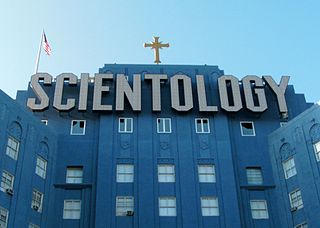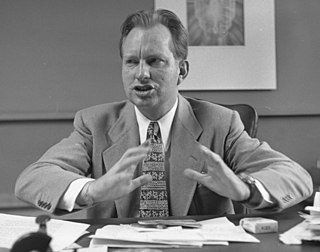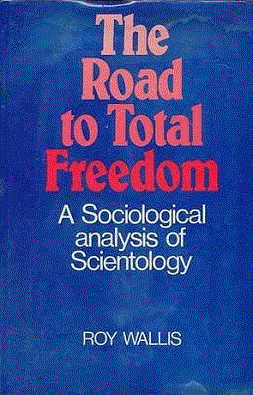
Lafayette Ronald Hubbard was an American author, primarily of science fiction and fantasy stories, who is best known for having founded the Church of Scientology. In 1950, Hubbard authored Dianetics: The Modern Science of Mental Health and established a series of organizations to promote Dianetics. In 1952, Hubbard lost the rights to Dianetics in bankruptcy proceedings, and he subsequently founded Scientology. Thereafter, Hubbard oversaw the growth of the Church of Scientology into a worldwide organization.

Xenu, also called Xemu, is a figure in the Church of Scientology's secret "Advanced Technology", a sacred and esoteric teaching. According to the "Technology", Xenu was the extraterrestrial ruler of a "Galactic Confederacy" who brought billions of his people to Earth in DC-8-like spacecraft 75 million years ago, stacked them around volcanoes, and killed them with hydrogen bombs. Official Scientology scriptures hold that the thetans of these aliens adhere to humans, causing spiritual harm.

The Church of Scientology maintains a wide variety of beliefs and practices. The core belief holds that a human is an immortal, spiritual being (thetan) that is resident in a physical body. The thetan has had innumerable past lives, some of which, preceding the thetan's arrival on Earth, were lived in extraterrestrial cultures. Based on case studies at advanced levels, it is predicted that any Scientologist undergoing auditing will eventually come across and recount a common series of events.

The Sea Organization is a Scientology organization, which the Church of Scientology describes as a "fraternal religious order, comprising the religion’s most dedicated members". All Scientology management organizations are controlled exclusively by members of the Sea Org. David Miscavige, the de facto leader of Scientology, is the highest-ranking Sea Org officer, holding the rank of captain.

R2-45 is the name given by L. Ron Hubbard to what he described as "an enormously effective process for exteriorization but its use is frowned upon by this society at this time". In Scientology doctrine, exteriorization refers to the separation of the thetan (soul) from the body, a phenomenon which Hubbard asserts can be achieved through Scientology auditing. R2-45 is said to be a process by which exteriorization could be produced by shooting a person in the head with a .45 pistol. This literal meaning is acknowledged by the Church of Scientology, although they deny that it is meant seriously.

The Foster Report is a 1971 report titled Enquiry into the Practice and Effects of Scientology, written by Sir John Foster for the government of the United Kingdom, regarding the Church of Scientology. The report made its case with L. Ron Hubbard's own words and reprinted a number of the Church's internal Ethics Orders. It concluded that it would be unfair to ban Scientology outright, but asked for legislation to ensure that psychotherapy in the United Kingdom is "a restricted profession open only to those who undergo an appropriate training and are willing to adhere to a proper code of ethics," and that the Scientology version of "ethics" did not meet such criteria.

Stephen A. Kent is a professor in the Department of Sociology at the University of Alberta in Edmonton, Alberta, Canada. He researches new religious movements (NRMs), and has published research on several such groups including the Children of God, the Church of Scientology, and other NRMs operating in Canada.

Ronald Edward "Ron" DeWolf, also known as "Nibs" Hubbard, was the eldest child of Scientology's founder L. Ron Hubbard by his first wife Margaret Louise Grubb. He is known for having been highly critical of his father and of the Church of Scientology.

Paulette Cooper is an American author and journalist whose writing against the Church of Scientology resulted in harassment from Scientologists. An early critic of the church, she published The Scandal of Scientology in 1971. She endured many years of attacks from church leadership and their agents, including lawsuits, smear campaigns, overt and covert surveillance, outright threats, and even a criminal frame-up. Church founder and leader L. Ron Hubbard was reportedly obsessed with her and personally plotted against her.

A Piece of Blue Sky: Scientology, Dianetics and L. Ron Hubbard Exposed is a 1990 book about L. Ron Hubbard and the development of Dianetics and Scientology, authored by British former Scientologist Jon Atack. It was republished in 2013 with the title Let's sell these people A Piece of Blue Sky: Hubbard, Dianetics and Scientology. The title originates from a quote of Hubbard from 1950; an associate of Hubbard's noted him saying that he wanted to sell potential members "a piece of blue sky".
The Church of Scientology publicly classifies itself as a religion, but scholars and other observers regard it as a business, because the organization operates more like a for-profit business than a religious institution. Some scholars of sociology working in religious studies consider it a new religious movement. Overall, as stated by Stephen A. Kent, Scientology can be seen as a "multi-faceted transnational corporation that has religion as only one of its many components. Other components include political aspirations, business ventures, cultural productions, pseudo-medical practices, pseudo-psychiatric claims, and, an alternative family structure."

L. Ron Hubbard, Messiah or Madman? is a posthumous biography of Scientology founder L. Ron Hubbard written by Bent Corydon, which makes extensive use of interviews he conducted with Hubbard's son Ronald DeWolf. Though originally published in 1987 by Lyle Stuart Inc., the book was re-issued in a paperback edition on July 25, 1992, and a hardcover edition in October 1995, both by publisher Barricade Books. The 1995 edition also featured Brian Ambry as principal researcher. The first edition of the book listed DeWolf as coauthor.

The Scandal of Scientology is a critical exposé book about the Church of Scientology, written by Paulette Cooper and published by Tower Publications, in 1971.

Scientology: The Now Religion is a book on Scientology, written by George Malko. The book was the first full-length analysis of the history surrounding the founding of the Church of Scientology, and L. Ron Hubbard. The author conducted interviews with members, and provides analysis about certain practices. The book was published in 1970 in Hardcover format by Delacorte Press, and then in a paperback edition in 1971, by Dell Publishing. The Church of Scientology fought to prevent the sale of the book.
Roy Wallis (1945–1990) was a sociologist and Dean of the Faculty of Economics and Social Sciences at the Queen's University Belfast. He is mostly known for his creation of the seven signs that differentiate a religious congregation from a sectarian church, which he created while researching the Church of Scientology. He introduced the distinction between world-affirming and world-rejecting new religious movements.

Scientology is a set of beliefs and practices invented by the American author L. Ron Hubbard, and an associated movement. It has been variously defined as a cult, a business, or a new religious movement. Its adherents are called Scientologists. The primary exponent of Scientology is the Church of Scientology, a centralized and hierarchical organization based in Florida, although many practitioners exist independently of the Church, in what is called the Free Zone. Estimates put the number of Scientologists at under 40,000 worldwide.
Scientology in the United Kingdom is practised mainly within the Church of Scientology and its related groups which go under names including "Hubbard Academy of Personal Independence" and "Dianetics and Scientology Life Improvement Centre". The national headquarters, and former global headquarters, is Saint Hill Manor at East Grinstead, which for seven years was the home of L. Ron Hubbard, the pulp fiction author who created Scientology. In the 2021 census, there were 1,844 individuals in England and Wales who listed themselves as Scientologists in their census returns, almost half of which lived in the area around East Grinstead in West Sussex, which hosts the British Scientology Headquarters at Saint Hill Manor. This is a decline of just under a quarter since census day, 2011.
The intersection of Scientology and abortion has a controversial history which began with Scientology founder L. Ron Hubbard's discussion of abortion in his 1950 book Dianetics: The Modern Science of Mental Health. Hubbard wrote in Dianetics that abortion and attempts at abortion could cause trauma to the fetus and to the mother in both spiritual and physical ways. Scientologists came to believe that attempted abortions could cause traumatic experiences felt by the fetus, which would later be remembered as memories referred to in Scientology as "engrams". In the Scientology technique called Auditing, Scientologists are frequently queried regarding their sexual feelings and behaviors. These questions about Scientologists' sexual behavior are often posed to members during "security checks", a specific form of auditing sessions where individuals are required to document their divergence from the organization's ethics. One of the questions asked in these security checks is, "Have you ever been involved in an abortion?".

The Road to Total Freedom: A Sociological Analysis of Scientology is a non-fiction book about Scientology by sociologist Roy Wallis. Originally published in 1976 by Heinemann, it was republished in 1977 by Columbia University Press. The original manuscript was the product of Wallis's doctoral research at Oxford under the tutelage of Bryan Wilson. Wallis, after a review of the original manuscript by Scientology leaders, made edits to about 100 passages before publication.
This is a bibliography of books critical of Scientology and the Church of Scientology, sorted by alphabetical order of titles.












